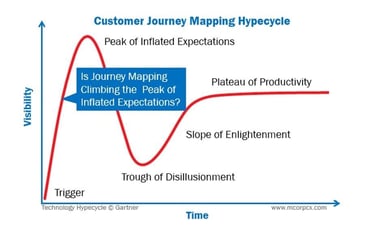Customer Experience Journey Mapping
 Many of us are familiar with Gartner’s “hypecycle,” representing the maturity, adoption and social application of specific technologies. At core, the hypecycle is all about helping people understand what’s real – and what’s hype
Many of us are familiar with Gartner’s “hypecycle,” representing the maturity, adoption and social application of specific technologies. At core, the hypecycle is all about helping people understand what’s real – and what’s hype
– when new ideas come along that make (or are perceived to be able to deliver) big promises. And while customer journey mapping isn’t actually a technology, I think it’s time to apply the hypecycle lens to it. After all, the focus on journey mapping as a silver bullet for customer experience improvement is something CX practitioners have noticed for some time. Reality? Customer journey maps are often thought of as “the” solution to customer experience improvement efforts. But they’re not. As any customer experience consultant or practitioner knows, there’s a lot more to improving customer experience than the creation of journey maps.
That said, customer journey maps are a key tool for looking at an organization from the outside-in, and gaining a better understanding of customer wants, needs and pain, as well as opportunities for improvement. As great as the promise of customer maps is, we suspect they’re climbing the Peak of Inflated Expectations.
So let’s look at each of the five phases of the “Customer Experience Journey Mapping Hypecycle” both to see where your organization might be today, and where the true promise of journey maps we might be in the future.
The Trigger: The value and promise of customer experience
Though CX has been around some time (at least since 2002 when we started!), it’s more recent that there’s been a huge breakthrough in recognition of its value. Stories of the radical advantage CX leaders enjoy (like typical growth over double that of their competitors, or 2.5 times greater annual revenue per customer) have driven fevered interest. Everyone wants to get it, but only a handful are all in. 9 of 10 execs to say CX is critical to their future success.
Peak of Inflated Expectations: As complex as customer experience is, journey mapping looks easy.
It seems like any company can do – it many are. When you see how much value companies that actively manage customer experience and customer journeys gain (companies with a program in place enjoy over 50 percent better marketing return on investment, over 250 percent more revenue from customer referrals to name just a couple) it’s easy to see the hype. Yet still, only a third of companies have established customer journey maps.
Trough of Disillusionment: Customer experience is hard to do – and journey maps can’t fix it alone.
Even those orgs that say putting customers first is a key priority (yea, we’re talking about you John Stumpf) have a really hard time getting it right. This also means that journey maps (as we already know) aren’t going to solve the customer experience puzzle. As the reality of “customer centricity” and what that actually means in practice bumps up against entrenched attitudes, journey maps are likely to fall out of favor or simply become a “check box” for business process or marketing teams to check.
Slope of Enlightenment: Better understanding customer journey maps, and where they fit.
As more companies actually figure out how to do customer journey mapping right – bringing cross-functional teams together, knocking down silos by appropriately socializing maps and driving action – it will become more and more obvious how journey maps can benefit the enterprise, and they’ll become more widely understood, and used. More and more companies will explore pilot journey management programs, even as more cautious firms hold back.
Plateau of Productivity: Journey mapping truly takes off.
As the approaches to and benefits of customer journey management become broadly understood across industries and company types, executives will start to climb on the bandwagon in bigger numbers. No longer a “dark art,” the tools for and knowledge of how to create and use them (along with measurable top- and bottom-line results) will make them a regular part of the way every company works to better understand and serve their customers.
Today, we’re pretty sure that we’re climbing the “Peak of Inflated Journey Mapping Expectations.” But we know that the path forward – though currently a complex and resource-intensive exercise for most organizations – is one with a huge payoff at the end.
Because as companies work through their own journey mapping hypecycles, we know that landing on the “plateau of productivity” delivers a better understanding of the customer, a clear cross-org pictures of ways to serve those customers better, and a better customer experience, all-up.
Now that’s a payoff worth climbing a couple peaks to reach!

